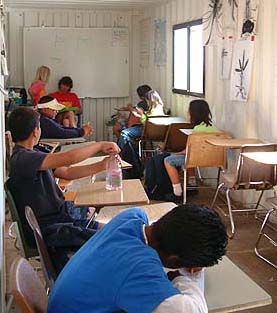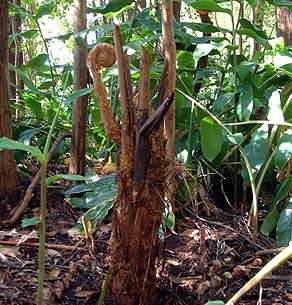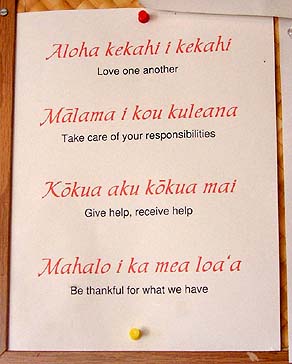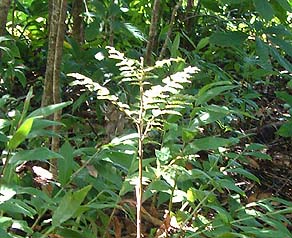 |
 |
 |
|||||
|
|
|||||||
|
|
|
|
|
“We’ve been dreaming of the day when we have control over our own education for a very long time," Ku says, "because we’re the only native peoples within the United States who somehow are not part of a movement that started many decades ago for self-determination in education. And we’ve been working toward that for a long, long time. "Specifically, we started in 1992 with an Education Action Research Project that looked at how our kupuna learned, and whether that way of learning is still applicable today. We did several one-month immersion programs in the environment."
|
||
|
|
||
“That worked extremely well, so in 1997 we started a school-within-a-school that was called Kanu o ka ‘Aina, the Hawaiian Academy at Honoka‘a. That was only for grades nine to twelve. And then in 2000 we transitioned to a K-12 charter school, Kanu o ka ‘Aina charter school. We are Hawai‘i’s first native-designed and controlled charter school. This is our fifth year of operation now. “The reality right now is that the current system of education in the United States is not really working for anybody. And it’s not working for the White guys, not working for the Black guys, it’s not working for the Red guys, it’s not really working for anybody. Educational reform comes in waves every twenty years. And there’s little pockets that do something innovative. "But in general, the whole system is exactly how our parents went to school, even our grandparents: the same format, with the board in the front and the students sitting in the chairs for six periods a day."
|
|
|
“There are many examples of how our kupuna learned. And a lot of it is watching, listening and doing, which is a very native way of doing things. Not by asking questions when the subject hasn’t even been fully explained yet, or just listening to a lecture about something that’s completely irrelevant and then being told to spit back that information in a written test. That’s not how it works. "Our kupuna learned, first of all, by listening and learning. So there’s a lot of observation.The learning styles of our students are the learning styles of our ancestors, and we try to tailor the instruction according to those learning styles. "And so there’s a lot of peer learning and peer teaching, because that’s how we learned traditionally. The younger ones learn from the older ones. That’s why we have a multi-age format."
|
|
|
|
"We integrate technology at an extremely high level, which is an essential component for survival, but it’s not the only component. We have an extremely strong career explorations program, including a senior project, so none of our kids leave without knowing what’s going to happen to them after high school, and they have plans. "And what we hope is that they will take with them the values—we call them Hawaiian values, but they’re certainly not exclusively Hawaiian values—that they will make good decisions in terms of the types of careers that they choose. So we certainly don’t promote golf course maintenance as a career path, because all you’re going to be doing is spraying poison all day, and that’s not the kind of job we’re training the students for. And if that’s what the parents want, then we are not the right program for them."
|
||
|
|
||
"But we are the right school if they would like their kids to get into forestry, or into agriculture and horticulture and into fishing—things that fall within the Hawaiian value system, a system of ecological and environmental awareness and protection. "We don’t have anything against people going into business, but not with a cut-throat kind of a mentality of ‘How many people can I step on to get to the top as fast as possible.’ But instead, looking at business as economic development where everybody gives and takes and we all grow and prosper, rather than ‘I’m becoming a billionaire and you’re going to be cleaning my toilets’ type of a mentality. "So in that way, we have been designed specifically to prepare students to become leaders in the twenty-first century."
|
|
|
"I think our four ‘olelo no‘eau [proverbs] pretty much guide all behavior and expectations, not just among the students, but also the staff here at Kanu. These really sum up for us what is the important way of interacting. "First is ‘Aloha kekahi a kekahi.’ Our research over the last ten years or so shows that it’s the aloha that distinguishes this school from other schools, and it’s the aloha that turns the kids on, and it’s the aloha that makes them perform things that they never thought they could perform. So aloha is definitely one of the main values. "The next one is ‘Malama i kou kuleana.’ That means to understand our kuleana and to take care of that kuleana. If we all did that, half of the problems in this world would not exist. There would be no Iraq problem if we all took care of our kuleana in our own backyards and didn’t mess with other people’s kuleana."
|
|
|
|
"The next one is ‘Kokua aku, kokua mai,’ the idea of 'reciprocal help,' that we all can learn from each other, that we can all share in it together, and if we do that we are going to be so much better off. "And the fourth one is ‘Mahalo i ka mea loa‘a,’ 'be appreciative of what we have.' This world is so ‘me, me, me’ oriented; ‘it’s all about me’ it says on some t-shirts, and it’s so not about you. It’s about so much more, and if people can be appreciative of what they have instead of being so greedy and wanting more and more and more, a lot of world crises could be prevented in that way."
|
|
|
"That’s the four ‘olelo no‘eau that really drive our whole school, and collectively they allow us to kuli i ka nu‘u, which means 'to strive to reach your highest level.' " We feel that if every single individual would make that their personal motto, not in terms of striving to reach the highest level of how much money they can make, but really the highest level as to how they can kokua aku, kokua mai; aloha kekahi a kekahi, malama i kou kuleana, then I think we will once again have a very strong nation. "And as a people, we will be a part of a bigger community of nations with our separate and unique—yet not oppositional—kind of a culture."
|
|
|
|
"Our long range plan is the liberation of fifty-thousand Hawaiians from the public school system, and that’s the big picture. We have one hundred and fifty students, but we’re restricted by our physical campus to that number. However, even when our permanent campus is completed, we want to keep it small. We really feel that the success of the school has been directly related to our familial atmosphere and the type of relations that exist between the students, the parents, the staff, the teachers and the families in general. "We really are learning ‘ohana and that is something that can only really truly be if we stay small enough. If you have a thousand kids, there’s no way that everybody can know everybody."
|
||
|
|
||
Replanting traditional culture and values also takes place at an annual ceremony at Pu‘u Kohola, one of the sacred sites of Kawaihae.
|
||
|
|
||
|
|
|
|
|
|

|
| Kawaihae Home | Map Library | Site Map | Hawaiian Islands Home | Pacific Worlds Home |
|
|
|
|
|
|
|||
| Copyright 2006 Pacific Worlds & Associates • Usage Policy • Webmaster |
|||











